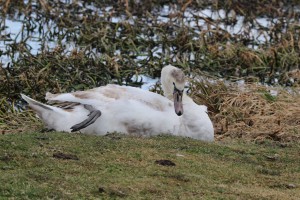 One of the frustrating aspects of watching birds is that more often than not we just do not know how old they are. One clue is from ringing birds and amongst many other valuable aspects of these studies is that sometimes a bird’s age can be worked out. With most small birds, such as the blue tits, chaffinches and siskins that come into the garden the birds are relatively short lived. This means that in most cases they will breed the year after they have fledged. The average life span of such birds is often only two or three years. Ringing shows just how old they can be, such as a blue tit shown to be nine years, a chaffinch at fourteen years and a siskin at 13 years but these are very exceptional.
One of the frustrating aspects of watching birds is that more often than not we just do not know how old they are. One clue is from ringing birds and amongst many other valuable aspects of these studies is that sometimes a bird’s age can be worked out. With most small birds, such as the blue tits, chaffinches and siskins that come into the garden the birds are relatively short lived. This means that in most cases they will breed the year after they have fledged. The average life span of such birds is often only two or three years. Ringing shows just how old they can be, such as a blue tit shown to be nine years, a chaffinch at fourteen years and a siskin at 13 years but these are very exceptional.
In contrast, the larger birds live much longer and at the same time they often take a few years before they are adult enough to actually breed. I saw a good example of this last week at Loch Farr in Strathnairn where a resident pair of mute swans had bred last year. It is still slightly early for them to be on eggs although it will not be long before they add to last year’s huge nest and lay their very large eggs, between five to seven. Mute swans do not attain their full breeding plumage until they are four years old. The immature birds can be identified during these few years by the amount of brown feathers in their body plumage compared with the all-white appearance of the adults. In the last year, the brown feathers may well have turned white but the orange beak does not come until the bird is ready to breed.
For the first winter the family of mute swans stay together but at this time of the year there is a problem. The adults want to get on with breeding so they have to push the young birds, often their own offspring, out of their territory. This could be seen on Loch Farr where the six young birds of last year had been forced out of the territory and were at one end on a bank. The juvenile bird in the photograph shows the typical brownish plumage. Note the leg as these powerful feet are used to defend the bird against predators. During the breeding season such young birds will often form flocks on their own and sometimes many birds are involved. Once these young birds start to breed they pair for life or until one of them dies and then another mate is found. One adult mute swan was shown, by ringing, to be 26 years old!
There are other examples of this longevity and one of the most renowned ones is a common seabird, the fulmar. These breed all around the coasts, including islands and often in large numbers. Around Inverness, even on small cliffs, there are fulmars nesting and the current breeding number for Scotland is a staggering half a million pairs. A very successful breeding bird indeed. One of the nearest colonies is on the North Sutor cliffs at Cromarty. Ringing has shown that one fulmar lived for 40 years. Fulmars do not start breeding until they are around 6-10 years old although they will return to potential breeding cliff after 5 years. During those first five years they literally just wander over the oceans, true masters of flight. The fulmar is famous for the fact that the St. Kildan’s harvested them for food, feathers and oil along with the puffins and gannets
Tags: highland wildlife
